It’s official – Uber and Lyft are not leaving California, yet. What happened and what could this mean for cities and states around the United States? Senior RSG contributor Paula Gibbins breaks down what’s going on with Uber, Lyft and California and what you need to know about it.
How did we get here? That’s what many are wondering in the wake of Uber and Lyft almost leaving California at the last minute – even if it would have only been temporary.
How did we get to where we are now, with Uber and Lyft making statements about leaving California and drivers wondering if, at the last second, they would need to find new opportunities?
Quick summary:
- Uber and Lyft are not leaving California right now
- This does not mean they’re off the hook for classifying drivers as employees!
- Oral arguments will be held mid-October, and the ruling could come down against Uber and Lyft
- By September 4, Uber and Lyft will have to submit a statement saying they have developed plans to make drivers employees, in case the court doesn’t rule in their favor or if Prop 22 fails
- Uber and Lyft would prefer Proposition 22 succeed at the ballot box in November
A Quick Summary of Assembly Bill 5 (AB5)
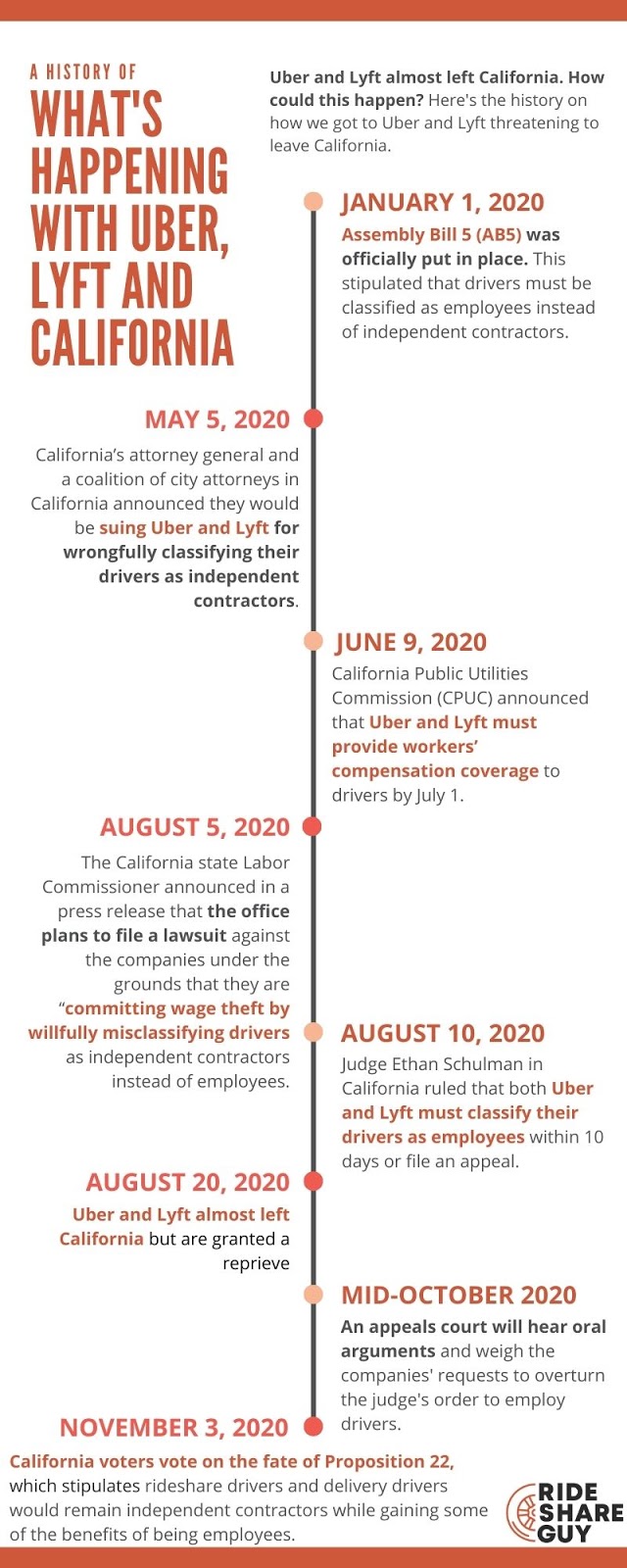
To start, we’ll go all the way back to January 1, 2020 when Assembly Bill 5 (AB5) was officially put in place. AB5 named that workers can be hired as and called independent contractors, if it’s proven:
- (A) that the worker is free from the control and direction of the hirer in connection with the performance of the work, both under the contract for the performance of such work and in fact.
- (B) that the worker performs work that is outside the usual course of the hiring entity’s business
- (C) that the worker is customarily engaged in an independently established trade, occupation, or business of the same nature as the work performed for the hiring entity.
Many believe that Uber and Lyft are unable to pass the ABC test (as described above) and therefore should treat their drivers as employees instead of independent contractors, which leads to the next step.
Uber and Lyft have opposed the enforcement of AB5 and have funded a ballot initiative now known as Proposition 22. The proposition details that rideshare drivers and delivery drivers would remain independent contractors while gaining some of the benefits of being employees.
Among the benefits are guaranteed minimum wages and health care benefits, all while being able to continue to enjoy the flexibility of gig work. Prop 22 is on the November ballot and voters in California will decide the fate of rideshare drivers.
On May 5, 2020, California’s attorney general and a coalition of city attorneys in California announced they would be suing Uber and Lyft for wrongfully classifying their drivers as independent contractors.
Uber and Lyft claim they are technology platforms and not transportation companies. To help shape their narrative, Uber has rolled out changes for California drivers, such as drivers now having the ability to see passenger destinations, removal of acceptance rates, ending flat rate surge and more.
Then on June 9, 2020, the California Public Utilities Commission (CPUC) announced that Uber and Lyft must provide workers’ compensation coverage to drivers by July 1.
From there, on August 5, 2020, the California state Labor Commissioner announced in a press release that the office plans to file a lawsuit against the companies under the grounds that they are “committing wage theft by willfully misclassifying drivers as independent contractors instead of employees.
Recent Rulings: Will Uber and Lyft Leave California?
On August 10, 2020, a judge in California ruled that both Uber and Lyft must classify their drivers as employees within 10 days or file an appeal.
The rest unfolded quickly. Uber and Lyft announced shortly after the judge ruling that they might leave California, hopefully temporarily. Upending business like that would leave drivers and passengers in the lurch with few options at hand. Both are curious to know how they will go on from here.
On Thursday, August 20, 2020, an appeals court granted Uber and Lyft a temporary reprieve.
What does this reprieve mean? According to The New York Times, this reprieve will allow Uber and Lyft to continue operating while the court weighs their appeal. Oral arguments in the case are set for mid-October. As the New York Times reports:
“An appeals court is weighing the companies’ requests to overturn a judge’s order to employ drivers, but it is not clear when the court will issue a ruling. The court has ordered Uber and Lyft to submit plans for hiring employees by early September, in case the court does not decide in their favor.”
A Lyft spokesperson stated: “While we won’t have to suspend operations tonight, we do need to continue fighting for independence plus benefits for drivers. That’s the solution on the ballot in November, and it’s the solution drivers want because it preserves their ability to earn and to use the platform as they do now — whenever they want — while also getting historic new benefits. Without it, 80-90% of Californians who earn on app-based platforms will lose that opportunity.”
What Do Drivers Really Want?
In May, we sent out a survey to our email list and the results showed that 71% of Uber and Lyft drivers want to remain independent contractors.
This is down slightly from our survey before the Covid-19 pandemic. But it’s still dramatically more than those who want to become employees.
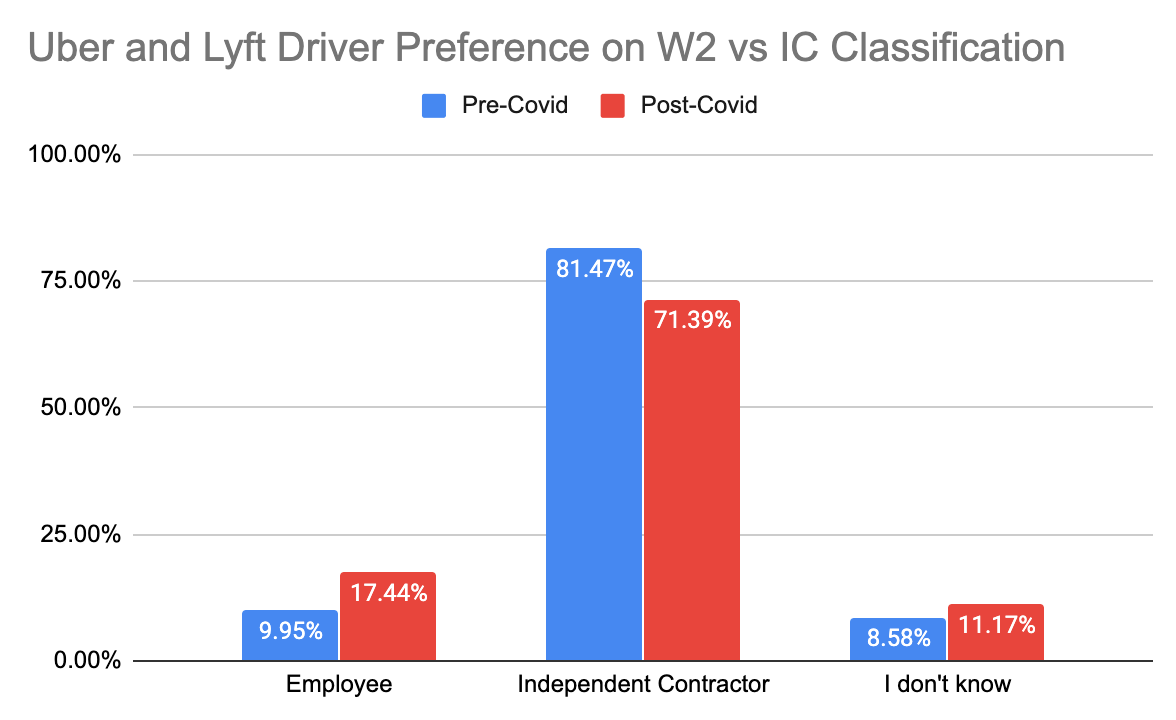 In comparison, post-Covid, 17.44% of drivers surveyed want to become employees.
In comparison, post-Covid, 17.44% of drivers surveyed want to become employees.
Do drivers want to be independent contractors? According to our recent Uber driver survey we sent out to our readers, drivers would rather be independent contractors than employees – even if it means they don’t get benefits.
Instead, drivers would rather trade having benefits in favor of having Lyft and Uber put a cap on how many drivers can be driving in their area.
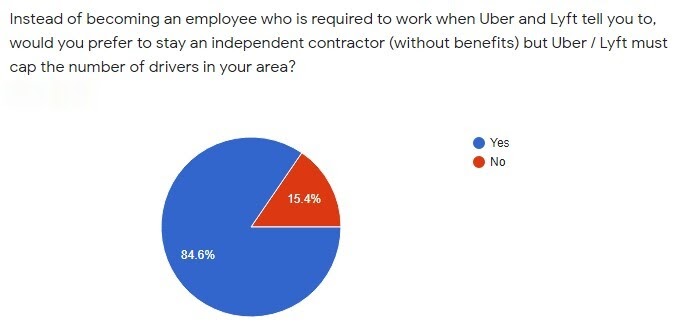
84.6% of drivers surveyed would rather have Uber and Lyft cap the number of drivers in their area and remain independent contractors.
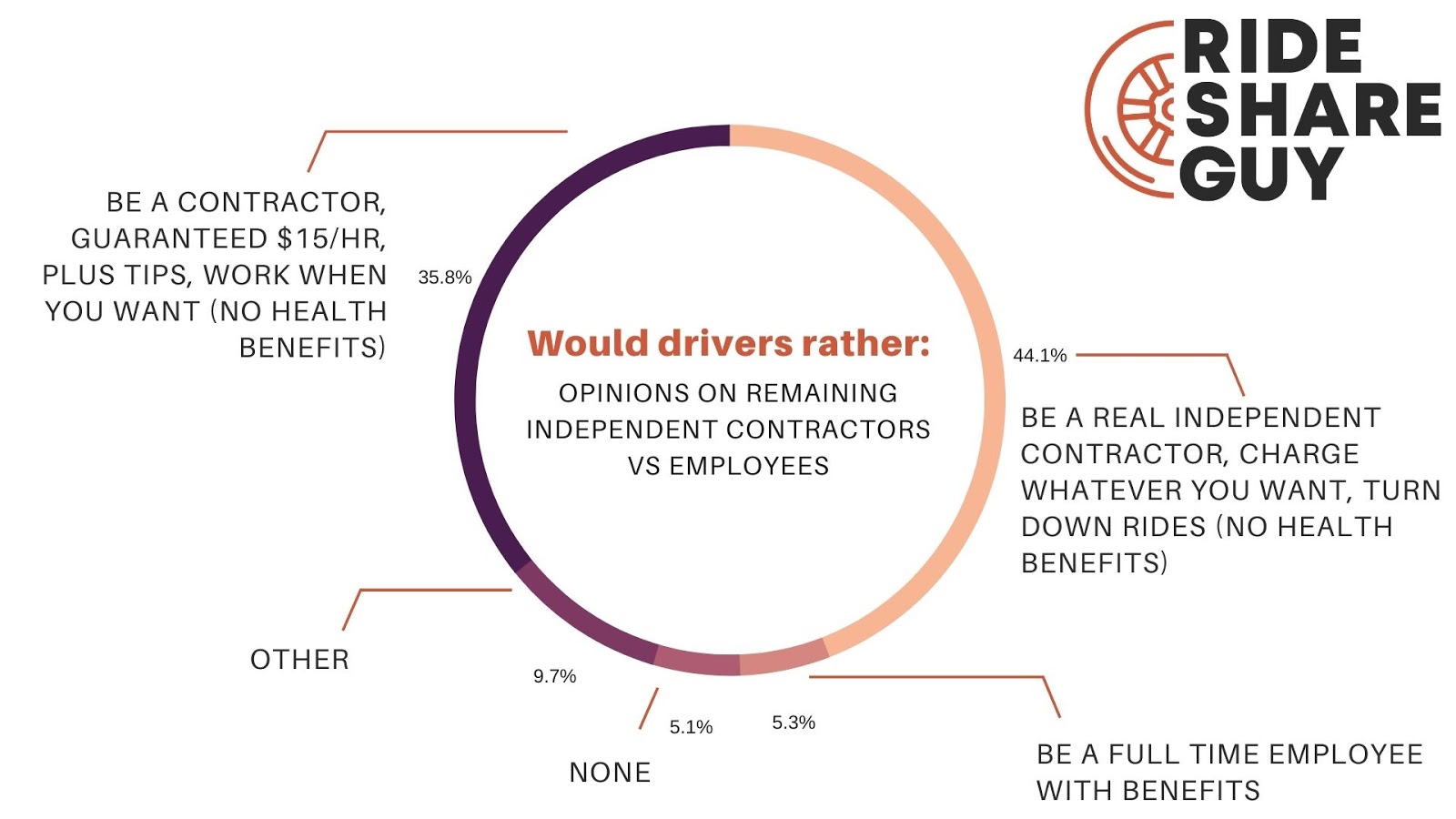
44.1% of drivers surveyed would rather be a “real” independent businessperson who can charge customers whatever they want and turn down whatever rides you want.
35.8% surveyed said they would rather be a contractor who is guaranteed $15 per hour plus tips when you have the app on, allowing them to work when and where they want without benefits.
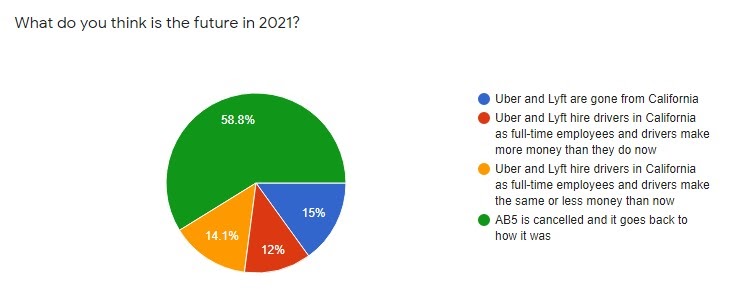
Finally, 58.8% predict that AB5 will be canceled and things go back to how they were in 2021.
Uber and Lyft Weigh Their Options Moving Forward
What options do Uber and Lyft have instead of turning drivers into employees? We’ll break down what Uber and Lyft could be looking at moving forward.
Wait for Proposition 22 to Win at the Ballot
The best option for Uber and Lyft is for Proposition 22 to win at the ballot this November. Below is the ballot summary for Proposition 22:
- Classifies drivers for app-based transportation (rideshare) and delivery companies as “independent contractors,” not “employees,” unless company: sets drivers’ hours, requires acceptance of specific ride and delivery requests, or restricts working for other companies.
- Independent contractors are not covered by various state employment laws—including minimum wage, overtime, unemployment insurance, and workers’ compensation.
- Instead, independent-contractor drivers would be entitled to other compensation—including minimum earnings, healthcare subsidies, and vehicle insurance.
- Restricts certain local regulation of app-based drivers.
- Criminalizes impersonation of drivers
It’s most likely that Uber and Lyft are hoping Proposition 22 will win the support of voters in the November election. This will end the question of ‘employee vs contractor’ and make an appeals decision unnecessary.
Regarding the situation and back and forth among Uber, Lyft and the state of California, Harry Campbell said, “[If Uber and Lyft left California], quite a few drivers will leave California entirely, or look for other full-time/temp work. Given the massive unemployment right now, it’s not a good look for California to throw thousands of drivers off the Uber/Lyft platform.”
Franchise-Model
One they are considering is a franchise-like model where the companies would license their brands out to vehicle fleet operators in California.
Uber is already familiar with this kind of operation because that’s what they do in Germany and Spain.
It’s possible that this might not even work for Uber and Lyft in California, however.
We reached out to an expert in franchising, Senior Director of Development for Oakscale Joseph Sexton, for his opinion on how this could work. Sexton stated:
“Licensing can make sense as a work-around, but franchising is way too heavily regulated for them to just jump into it, especially in California. However, with licensing they have far less control over it. They can’t dictate a set of operational standards to comply with and the licensee can essentially run the business however they see fit while using the tech and trademarks.
It’s a risky move to let go of control in the most populous state in the country. Has potential to muddy the brand on a much larger scale if the licensees decide to do anything stupid.
Makes more sense for Bird chargers that don’t actually interact with the consumers at any level.”
Classify Drivers as Employees
If Uber and Lyft are forced to reclassify their drivers as employees, it’s possible a lot of drivers will permanently lose their jobs as drivers for these companies.
Dr. Williamson M. Evers, Senior Fellow at the Independent Institute in Oakland, CA said, “Uber and Lyft are businesses, not benevolence societies. They have to make money. Do not be surprised if these platforms skedaddle out of California. If they stay under these onerous conditions, 75% of drivers will lose their jobs.”
Dara Khosrowshahi, the CEO of Uber, also claimed something similar in his recently published op-ed in The New York Times:
“Why not just treat drivers as employees? Some of our critics argue that doing so would make drivers’ problems vanish overnight. It may seem like a reasonable assumption, but it’s one that I think ignores a stark reality: Uber would only have full-time jobs for a small fraction of our current drivers and only be able to operate in many fewer cities than today.
Rides would be more expensive, which would significantly reduce the number of rides people could take and, in turn, the number of drivers needed to provide those trips. Uber would not be as widely available to riders, and drivers would lose the flexibility they have today if they became employees.”
You can see how Uber’s CEO answered this question below during Harry’s interview with him here: My Interview with Uber CEO Dara Khosrowshahi
Turn Drivers Into True Independent Contractors
Another option Uber and Lyft could consider is following in Dumpling’s footsteps. Under this model, the company would help you get started in creating and running your own transportation business. It’s based on what Dumpling currently does for people wanting to start their own delivery business.
Dumpling offers a platform and the ability to process payments which are two things that someone wanting to start their own delivery business would need, and that could be a challenge for an individual to tackle on their own.
It would allow an individual to be truly an independent contractor, able to set their own rates, and operate where and when they want.
The Impact on Drivers Outside of California
California is not the only state that is suing Uber and Lyft. Massachusetts filed a lawsuit against the rideshare companies in July over misclassification of drivers.
Depending on how things play out in the next three months, other states might follow suit. But is that a good thing? Let’s take a look at NYC and what has happened there after a minimum wage was enforced, at a wage of $17.22/hour after expenses.
Once the minimum wage rule hit NYC and Uber and Lyft were made to comply, the rideshare apps increased the prices in order to counter the added funds they’d have to pay their drivers. From there, ride requests started to drop. The reasonable explanation is that passengers didn’t want to pay more.
With fewer ride requests, the next thing that happened was Uber and Lyft stopped accepting new drivers on their platforms in NYC. Without demand, there’s no need to keep resupplying. Part of the ruling made in NYC states that companies will be penalized for having too many cars on the road at a time without passengers on the city streets.
So, as a company, you’re having to pay drivers more and you’ll get punished if too many people are on the road. What do you do? You raise your rates, stop “hiring” new drivers and limit when drivers can be on your platform.
Takeaways/Stay Tuned
We understand this is a confusing situation for many, and even though Uber and Lyft were granted a reprieve, it’s understandable that drivers may want to consider some Plan Bs.
As Jay always says, if you’ve been working on your plan B, now is a good time to consider making changes and signing up for additional gig jobs just in case!
Drivers, what do you think about the news that Uber and Lyft will remain in California right now? Do you think Proposition 22 will pass or will Uber and Lyft eventually exit California?
-Paula @ RSG




